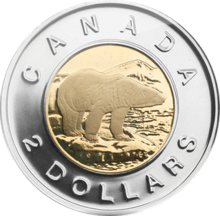Canada | |
| Value | 2.00 CAD |
|---|---|
| Mass | 6.92 g |
| Diameter | 28 mm |
| Thickness | 1.75 mm |
| Edge | Intermittent milled/smooth |
| Composition | |
| Years of minting | 1996–present |
| Catalog number | - |
| Obverse | |
 | |
| Design | Elizabeth II, Queen of Canada |
| Designer | Susanna Blunt |
| Design date | 2003 |
| Design discontinued | 2023 |
| Design | Charles III, King of Canada |
| Designer | Steven Rosati |
| Design date | 2023 |
| Reverse | |
 | |
| Design | Polar bear in early summer on an ice floe |
| Designer | Brent Townsend |
| Design date | 1996 |
| Design discontinued | 2012 |
 | |
| Design | Polar bear in early summer on an ice floe |
| Designer | Brent Townsend |
| Design date | 2012 |
The toonie (also spelled twonie[1][2] or twoonie[3][4]), formally the Canadian two-dollar coin (French: pièce de 2 dollars canadiens, nicknamed deux piastres or deux piastres rond), was introduced on February 19, 1996, by Minister of Public Works Diane Marleau. As of 2023,[update] it possesses the highest monetary value of any circulating Canadian coin. The toonie is a bi-metallic coin which on the reverse side bears an image of a polar bear by artist Brent Townsend. The obverse, since 2023, bear a portrait of King Charles III. It has the words CHARLES III / D.G. REX; before 2023, the words were in a typeface different to other Canadian coins.[5]
The coin is manufactured using a patented distinctive bi-metallic coin-locking mechanism.[6] The coins are estimated to last 20 years. The discontinued two-dollar bill was less expensive to manufacture but lasted only one year on average.[7]
On April 10, 2012, the Royal Canadian Mint (RCM) announced design changes to the loonie and toonie, which include new security features.[8][9]
Coins minted prior to 2012 consist of an aluminum bronze inner core with a pure nickel outer ring;[10] but in March–May 2012, the composition of the inner core switched to aluminum bronze coated with multi-ply plated brass, and the outer ring switched to steel coated with multi-ply plated nickel.[9] The weight dropped from 7.30 to 6.92 g, and the thickness changed from 1.8 to 1.75 mm. The Mint said that multi-ply plated steel technology, already used in Canada's smaller coinage, produces an electromagnetic signature that is harder to counterfeit than that of regular alloy coins; also, using steel provides cost savings and avoids fluctuations in the price or supply of nickel.[11][12]
- ^ International, Radio Canada (January 5, 2021). "Old Canadian banknotes lose legal tender status". RCI | English. Retrieved September 4, 2021.
- ^ "Toonie turns 20 years old". CBC. February 19, 2016. Retrieved November 27, 2022.
- ^ "Greater Sudbury to buy Ramsey Lake Island for a twoonie". CBC. February 24, 2015. Retrieved November 27, 2022.
- ^ Acres, Victoria (August 12, 2021). "'Twoonie Tuesdays' a hit in Rodney". thechronicle-online. Archived from the original on August 12, 2021. Retrieved November 27, 2022.
- ^ "A New Royal Era". Royal Canadian Mint. Retrieved January 7, 2024.
- ^ "Balance and composition – the 2-dollar coin". Royal Canadian Mint. Archived from the original on April 26, 2012. Retrieved November 27, 2022.
- ^ Fred Langan. "Canada's new coin a 'toonie'? By Fred Langan THE CHRISTIAN SCIENCE MONITOR - Tuesday, Feb. 20, 1996 | 11:59 a.m." Las Vegas Sun. Retrieved December 2, 2011.
- ^ Royal Canadian Mint. "The Loonie and Toonie have evolved". Royal Canadian Mint. Archived from the original on April 23, 2012. Retrieved November 27, 2022.
- ^ a b "The New $2 Coin". Royal Canadian Mint. Archived from the original on April 13, 2012. Retrieved April 21, 2012.
- ^ George S. Čuhaj; Thomas Michael (July 11, 2011). 2012 Standard Catalog of World Coins 2001 to Date. Krause Publications. p. 144. ISBN 978-1-4402-1575-9.[permanent dead link]
- ^ "Order Amending Part 2 of the Schedule to the Royal Canadian Mint Act". Canada Gazette. Government of Canada. Retrieved January 14, 2012.
- ^ "Material change in store for loonies, toonies". Montreal Gazette. Postmedia News. January 14, 2012.[permanent dead link]